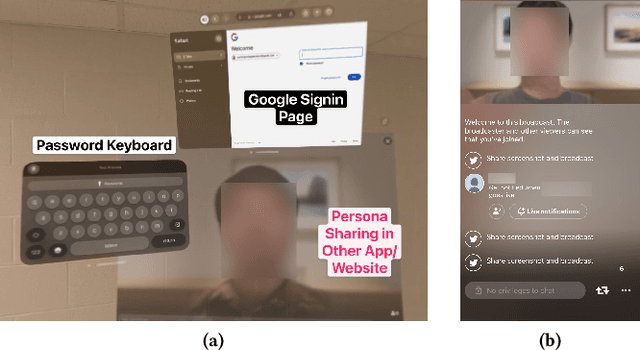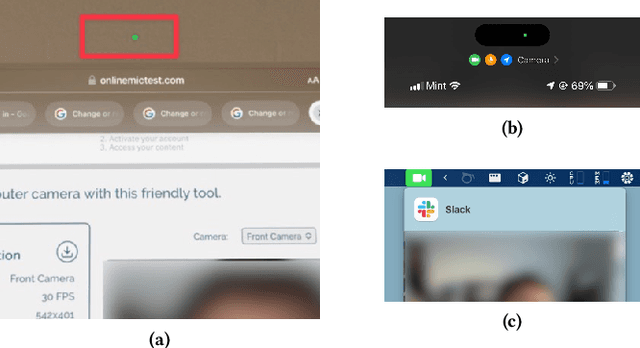Haoqi Shan
GAZEploit: Remote Keystroke Inference Attack by Gaze Estimation from Avatar Views in VR/MR Devices
Sep 12, 2024



Abstract:The advent and growing popularity of Virtual Reality (VR) and Mixed Reality (MR) solutions have revolutionized the way we interact with digital platforms. The cutting-edge gaze-controlled typing methods, now prevalent in high-end models of these devices, e.g., Apple Vision Pro, have not only improved user experience but also mitigated traditional keystroke inference attacks that relied on hand gestures, head movements and acoustic side-channels. However, this advancement has paradoxically given birth to a new, potentially more insidious cyber threat, GAZEploit. In this paper, we unveil GAZEploit, a novel eye-tracking based attack specifically designed to exploit these eye-tracking information by leveraging the common use of virtual appearances in VR applications. This widespread usage significantly enhances the practicality and feasibility of our attack compared to existing methods. GAZEploit takes advantage of this vulnerability to remotely extract gaze estimations and steal sensitive keystroke information across various typing scenarios-including messages, passwords, URLs, emails, and passcodes. Our research, involving 30 participants, achieved over 80% accuracy in keystroke inference. Alarmingly, our study also identified over 15 top-rated apps in the Apple Store as vulnerable to the GAZEploit attack, emphasizing the urgent need for bolstered security measures for this state-of-the-art VR/MR text entry method.
VoltSchemer: Use Voltage Noise to Manipulate Your Wireless Charger
Feb 18, 2024



Abstract:Wireless charging is becoming an increasingly popular charging solution in portable electronic products for a more convenient and safer charging experience than conventional wired charging. However, our research identified new vulnerabilities in wireless charging systems, making them susceptible to intentional electromagnetic interference. These vulnerabilities facilitate a set of novel attack vectors, enabling adversaries to manipulate the charger and perform a series of attacks. In this paper, we propose VoltSchemer, a set of innovative attacks that grant attackers control over commercial-off-the-shelf wireless chargers merely by modulating the voltage from the power supply. These attacks represent the first of its kind, exploiting voltage noises from the power supply to manipulate wireless chargers without necessitating any malicious modifications to the chargers themselves. The significant threats imposed by VoltSchemer are substantiated by three practical attacks, where a charger can be manipulated to: control voice assistants via inaudible voice commands, damage devices being charged through overcharging or overheating, and bypass Qi-standard specified foreign-object-detection mechanism to damage valuable items exposed to intense magnetic fields. We demonstrate the effectiveness and practicality of the VoltSchemer attacks with successful attacks on 9 top-selling COTS wireless chargers. Furthermore, we discuss the security implications of our findings and suggest possible countermeasures to mitigate potential threats.
A Review and Comparison of AI Enhanced Side Channel Analysis
Feb 03, 2024



Abstract:Side Channel Analysis (SCA) presents a clear threat to privacy and security in modern computing systems. The vast majority of communications are secured through cryptographic algorithms. These algorithms are often provably-secure from a cryptographical perspective, but their implementation on real hardware introduces vulnerabilities. Adversaries can exploit these vulnerabilities to conduct SCA and recover confidential information, such as secret keys or internal states. The threat of SCA has greatly increased as machine learning, and in particular deep learning, enhanced attacks become more common. In this work, we will examine the latest state-of-the-art deep learning techniques for side channel analysis, the theory behind them, and how they are conducted. Our focus will be on profiling attacks using deep learning techniques, but we will also examine some new and emerging methodologies enhanced by deep learning techniques, such as non-profiled attacks, artificial trace generation, and others. Finally, different deep learning enhanced SCA schemes attempted against the ANSSI SCA Database (ASCAD) and their relative performance will be evaluated and compared. This will lead to new research directions to secure cryptographic implementations against the latest SCA attacks.
 Add to Chrome
Add to Chrome Add to Firefox
Add to Firefox Add to Edge
Add to Edge